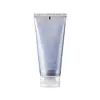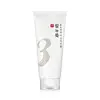What's inside
What's inside
 Key Ingredients
Key Ingredients

No key ingredients
 Benefits
Benefits

 Concerns
Concerns

 Ingredients Side-by-side
Ingredients Side-by-side

Water
Skin ConditioningMyristic Acid
CleansingGlycerin
HumectantPotassium Hydroxide
BufferingDipropylene Glycol
HumectantLauric Acid
CleansingPEG-32
HumectantPalmitic Acid
EmollientOryza Sativa Powder
Stearic Acid
CleansingGlycol Distearate
EmollientCocamidopropyl Betaine
CleansingBenzyl Glycol
SolventGlyceryl Stearate
EmollientLauramide DEA
Mannan
PEG-100 Stearate
Sodium Chloride
MaskingLauryl Betaine
CleansingButylene Glycol
HumectantEthylhexylglycerin
Skin ConditioningDisodium EDTA
Bentonite
AbsorbentPolyquaternium-7
Hydroxyethylcellulose
Emulsion Stabilising1,2-Hexanediol
Skin ConditioningLipase
Skin ConditioningPyrus Malus Juice
Skin ConditioningBeta Vulgaris Root Extract
Skin ConditioningDaucus Carota Sativa Juice
Skin ConditioningEuterpe Oleracea Fruit Extract
Vaccinium Angustifolium Fruit Extract
Skin ProtectingSodium Benzoate
MaskingVaccinium Macrocarpon Fruit Extract
AstringentPhyllanthus Emblica Fruit Extract
HumectantPolysorbate 60
EmulsifyingDisodium Phosphate
BufferingSodium Phosphate
BufferingParfum
MaskingWater, Myristic Acid, Glycerin, Potassium Hydroxide, Dipropylene Glycol, Lauric Acid, PEG-32, Palmitic Acid, Oryza Sativa Powder, Stearic Acid, Glycol Distearate, Cocamidopropyl Betaine, Benzyl Glycol, Glyceryl Stearate, Lauramide DEA, Mannan, PEG-100 Stearate, Sodium Chloride, Lauryl Betaine, Butylene Glycol, Ethylhexylglycerin, Disodium EDTA, Bentonite, Polyquaternium-7, Hydroxyethylcellulose, 1,2-Hexanediol, Lipase, Pyrus Malus Juice, Beta Vulgaris Root Extract, Daucus Carota Sativa Juice, Euterpe Oleracea Fruit Extract, Vaccinium Angustifolium Fruit Extract, Sodium Benzoate, Vaccinium Macrocarpon Fruit Extract, Phyllanthus Emblica Fruit Extract, Polysorbate 60, Disodium Phosphate, Sodium Phosphate, Parfum
Glycerin
HumectantWater
Skin ConditioningCellulose
AbsorbentSodium Cocoyl Glycinate
CleansingSodium Lauroyl Glutamate
Kaolin
AbrasiveDisodium Cocoamphodiacetate
Cleansing1,2-Hexanediol
Skin ConditioningHydrated Silica
AbrasiveLauryl Betaine
CleansingSodium Chloride
MaskingSodium Methyl Cocoyl Taurate
CleansingHydroxyacetophenone
AntioxidantEthylhexylglycerin
Skin ConditioningAcrylates/C10-30 Alkyl Acrylate Crosspolymer
Emulsion StabilisingCitric Acid
BufferingPolyglycerin-3
HumectantHexylene Glycol
EmulsifyingButylene Glycol
HumectantHydrogenated Lecithin
EmulsifyingFicus Carica Fruit Extract
HumectantCentella Asiatica Extract
CleansingBeta-Glucan
Skin ConditioningCeramide NP
Skin ConditioningCarbomer
Emulsion StabilisingHydroxypropyl Starch Phosphate
Glycerin, Water, Cellulose, Sodium Cocoyl Glycinate, Sodium Lauroyl Glutamate, Kaolin, Disodium Cocoamphodiacetate, 1,2-Hexanediol, Hydrated Silica, Lauryl Betaine, Sodium Chloride, Sodium Methyl Cocoyl Taurate, Hydroxyacetophenone, Ethylhexylglycerin, Acrylates/C10-30 Alkyl Acrylate Crosspolymer, Citric Acid, Polyglycerin-3, Hexylene Glycol, Butylene Glycol, Hydrogenated Lecithin, Ficus Carica Fruit Extract, Centella Asiatica Extract, Beta-Glucan, Ceramide NP, Carbomer, Hydroxypropyl Starch Phosphate
 Reviews
Reviews

Ingredients Explained
These ingredients are found in both products.
Ingredients higher up in an ingredient list are typically present in a larger amount.
1,2-Hexanediol is a synthetic liquid and another multi-functional powerhouse.
It is a:
- Humectant, drawing moisture into the skin
- Emollient, helping to soften skin
- Solvent, dispersing and stabilizing formulas
- Preservative booster, enhancing the antimicrobial activity of other preservatives
Butylene Glycol (or BG) is used within cosmetic products for a few different reasons:
Overall, Butylene Glycol is a safe and well-rounded ingredient that works well with other ingredients.
Though this ingredient works well with most skin types, some people with sensitive skin may experience a reaction such as allergic rashes, closed comedones, or itchiness.
Learn more about Butylene GlycolEthylhexylglycerin (we can't pronounce this either) is commonly used as a preservative and skin softener. It is derived from glyceryl.
You might see Ethylhexylglycerin often paired with other preservatives such as phenoxyethanol. Ethylhexylglycerin has been found to increase the effectiveness of these other preservatives.
Glycerin is already naturally found in your skin. It helps moisturize and protect your skin.
A study from 2016 found glycerin to be more effective as a humectant than AHAs and hyaluronic acid.
As a humectant, it helps the skin stay hydrated by pulling moisture to your skin. The low molecular weight of glycerin allows it to pull moisture into the deeper layers of your skin.
Hydrated skin improves your skin barrier; Your skin barrier helps protect against irritants and bacteria.
Glycerin has also been found to have antimicrobial and antiviral properties. Due to these properties, glycerin is often used in wound and burn treatments.
In cosmetics, glycerin is usually derived from plants such as soybean or palm. However, it can also be sourced from animals, such as tallow or animal fat.
This ingredient is organic, colorless, odorless, and non-toxic.
Glycerin is the name for this ingredient in American English. British English uses Glycerol/Glycerine.
Learn more about GlycerinLauryl Betaine is a surfactant. It helps cleanse your skin by gathering oil, dirt, and other pollutants to be rinsed away.
Chances are, you eat sodium chloride every day. Sodium Chloride is also known as table salt.
This ingredient has many purposes in skincare: thickener, emulsifier, and exfoliator.
You'll most likely find this ingredient in cleansers where it is used to create a gel-like texture. As an emulsifier, it also prevents ingredients from separating.
There is much debate on whether this ingredient is comedogenic. The short answer - comedogenic ratings don't tell the whole story. Learn more about comegodenic ratings here.
The concensus about this ingredient causing acne seems to be divided. Research is needed to understand if this ingredient does cause acne.
Scrubs may use salt as the primary exfoliating ingredient.
Learn more about Sodium ChlorideWater. It's the most common cosmetic ingredient of all. You'll usually see it at the top of ingredient lists, meaning that it makes up the largest part of the product.
So why is it so popular? Water most often acts as a solvent - this means that it helps dissolve other ingredients into the formulation.
You'll also recognize water as that liquid we all need to stay alive. If you see this, drink a glass of water. Stay hydrated!
Learn more about Water